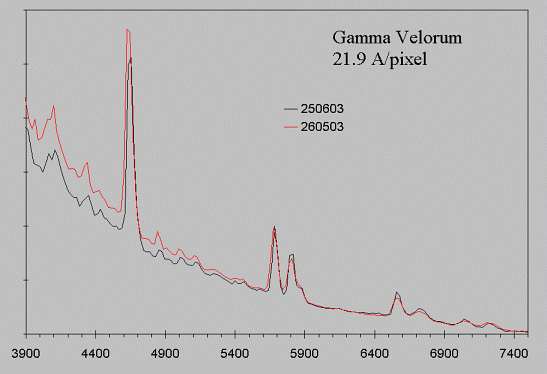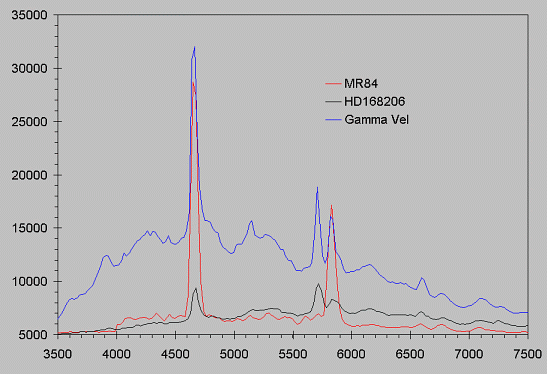
Spectroscopy of Wolf-Rayet stars

Gamma Velorum (a.k.a. WR11). This Wolf-Rayet star (hot and windy...) is well-known for its spectacular emission-line spectrum.The main emission lines do not, in fact, come mainly from hydrogen, but from He, N, O, C and Si. Vertical axis is arbitrary intensity, horizontal axis is in ┼ngstroms. This is a comparison of spectra taken a month apart. There is an apparent change in the continuum level shortwards of l5500; since the calibration process used is not absolutely thorough, and does not take into account differences in air-mass between object and calibration star, this may be due to atmospheric extinction.
![]()
Synthesised colour spectrogram (via VSpec) based on the above spectral data.

Comparison of Gamma Velorum, MR 84 and HD 168206 spectra. Vertical axis is arbitrary intensity; hroizontal axis is in ┼ngstroms.These plots have not been response-corrected, although wavelength calibration has been applied. They were made using the "View Slice" command in IRIS, after the "l_sky" command was used to subtract the sky background from the image (with "offset 5000" then being used to bring the pixel values back up to a base value around 5000). Note that this is not a true sky subtraction for the entire image, but it can be applied safely to the few rows occupied by a spectrum; it also yields an approximate flat-field correction to the spectrum, since the sky brightness is modulated by optical vignetting.
Even without response correction, it is possible to compare features between the various spectra. Firstly, the underlying continuum is different for each. For Gamma Velorum, the continuum is quite blue, especially given that the CCD response decreases considerably towards 4000┼. For HD168206, the continuum is much redder. Secondly, the intensity ratios between lines may be compared. These are markedly different; also, some lines are very weak, or absent, in some stars, but strong in others. Thirdly, the line strength (as compared with the strength of the continuum) varies between stars. For MR 84, the lines are much brighter than the continuum; this is not so for HD168206.
Shown below is a combined image of the spectra of these three stars, obtained using "l_add" in IRIS after using "l_sky" as before. The spectra were aligned in the x-direction using the zero-order images, and were then cropped. Each was then scaled such that the brightest pixel (i.e. the peak of the brightest emission line) in each image was at the same intensity. This allows one to see the relative intensity of lines within and between images, as well as the ratio between the peak line emission and the general continuum brightness:

: the order of spectra is Gamma Velorum / MR84 / HD 168206 top-to-bottom. For this image, wavelength increases to the right, as in the plot above.